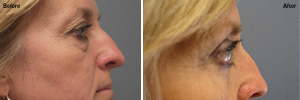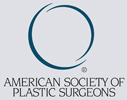Eye Lid Surgery

The eyes are our most intriguing and revealing facial feature — they draw attention and convey expression. Through them, we not only see others but others see us as well. Our interest and how how we feel physically or emotionally is reflected in our eyes. Unfortunately hereditary factors and the signs of aging can greatly impact the appearance of our eyes so that what they reflect is not really how we feel.
If you are bothered by upper eyelids with excess, drooping skin that makes you appear sad or angry, or by eyes that look tired due to puffiness or bags, cosmetic eyelid surgery may be right for you. In general, eyelid surgery corrects the excess skin, tissue and fat that contribute to puffiness and bags in both the upper and lower eyelids, revealing a more youthful and energetic appearance.
What Is Eyelid Surgery?
Cosmetic Eyelid Surgery, technically called blepharoplasty, is a surgical procedure to improve the appearance of the upper eyelids, lower eyelids, or both. Specifically, eyelid surgery can treat:
- Loose or sagging skin that creates folds or hides the natural contour of the upper eyelid
- Excess skin that hangs down from the upper eyelid, sometimes impairing vision
- Excess fatty deposits that appear as puffiness in the upper eyelids
- Bags under the eyes
- Droopiness of the lower eyelids, showing white below the iris
- Excess skin and fine wrinkles of the lower eyelid
These conditions typically appear as part of the natural aging process or due to heredity. Eyelid surgery removes excess skin, eliminates bags and restores firmness to the area surrounding the eye, making you look more rested and alert.
Most commonly, eyelid surgery is performed on adult men and women who have healthy facial tissue and muscles and have realistic goals for improvement of the upper and/or lower eyelids and surrounding areas. Good candidates are:
- Healthy individuals who do not have a life-threatening illness or medical conditions that can impair healing
- Non-smokers
- Individuals with a positive outlook and specific goals in mind for improvement through eyelid surgery
In addition, the following medical conditions are essential to disclose if you are considering eyelid surgery:
- Eye disease such as glaucoma, dry eye or detached retina
- Thyroid disorders such as Graves disease and under or overactive thyroid
- Cardiovascular disease, high blood pressure or other circulatory disorders or diabetes
Where Do I Begin?
A consultation with Dr. Paula Legere is the first step to learn how eyelid surgery can improve the appearance of your eyelids and the surrounding region. A consultation is designed to fully educate you about eyelid surgery in a non-pressured environment, and will include:
- A discussion of your goals and an evaluation of your individual case
- The options available for eyelid surgery
- The likely outcomes of surgery and the potential risks and complications
- The course of treatment recommended by Dr. Legere
Evaluation
Overall health and personal outlook can greatly impact the outcome of cosmetic eyelid surgery. These will be carefully evaluated in consultation with Dr. Legere. The success of your procedure, safety and overall satisfaction requires that you:
- Honestly share your expectations with Dr. Legere
- Fully disclose health history, current medications, the use of vitamins, herbal supplements, alcohol, tobacco, and drugs
- Commit to following all of Dr. Legere’s instructions precisely
Safety
By making the decision to consult with Dr. Legere and following all the instructions given, you are taking an important step in helping to assure your safety.
Dr. Paula Legere is certified by The American Board of Plastic Surgery. This certification designates surgeons who are specifically trained in plastic surgery of the face and entire body.
My Eyelid Surgery
Like any cosmetic procedure, eyelid surgery requires an individualized approach. Dr. Legere will evaluate patient anatomy, the condition you wish to have corrected, what is causing the condition and your realistic goals for improvement. Eyelid surgery can offer dramatic improvement in the upper and lower eyelids and surrounding regions. This degree of correction of drooping eyelids, puffiness or bags can only be achieved surgically, by repositioning muscle, redistributing fat that has settled into contours and when necessary by removing excess skin.
Skin resurfacing techniques (see Fraxel Laser) may be recommended to further improve the tone and surface appearance of skin surrounding the eye, and in some cases as a substitute for excision of minimal excess lower eyelid skin. Where a low positioned brow or crows’ feet at the outer corner of the eyes contribute to the aging appearance of the eyes, a browlift may be more appropriate then, or recommended in conjunction with eyelid surgery. In addition, a brow lift can also smooth a lined or furrowed forehead.
Step 1 – Anesthesia
Medications are administered for your comfort during the eyelid surgery procedure. The choices include intravenous sedation or general anesthesia. Dr. Legere will recommend the best choice for you.
Step 2 – The incision
The incision lines for eyelid surgery are designed for scars to be well concealed within the natural structures of the eyelid region.
Droopy conditions of the upper eyelid can be corrected through an incision within the natural crease of the upper eyelid allowing repositioning of fat deposits, tightening of muscles and tissue, and/or removal of excess skin.
Conditions of the lower eyelid may be corrected with an incision just below the lower lash line. Through this incision, excess skin in the lower eyelids is removed.
Step 3 – Closing the incisions
Eyelid incisions typically are closed with:
- Removable or absorbable sutures
- Skin adhesives
- Surgical tape
Step 4 – See the results
The results of eyelid surgery will appear gradually as swelling and bruising subside to reveal a smooth, better-defined eyelid and surrounding region, and an alert and rejuvenated appearance.
Preparing For Surgery
Dr. Legere will carefully explain the eyelid surgery procedure recommended for your specific case. Prior to surgery, you will be given specific instructions that may include:
- Pre-surgical considerations, diagnostic testing and medications
- Day of surgery instructions and medications
- Specific information related to the use of anesthesia
In addition, you will be asked so sign consent forms to assure Dr. Legere that you fully understand the procedure you will undergo and potential risks and complications. Risks associated with eyelid surgery include poor healing or infection at the incision site, temporarily blurred or impaired vision and dry eye. Difficulty closing your eyes is also possible, and usually temporary. These risks and others, as well as the risks associated with anesthesia will be discussed prior to your consent.
It is important that you address all your questions directly with Dr. Legere. It is natural to feel some anxiety, whether excitement for the anticipated outcomes or preoperative stress.
Discuss these feelings with Dr. Legere.
What To Expect
Once your procedure is complete, lubricating ointment and cold compresses may be applied, and in some cases your eyes may be loosely covered with gauze. Before being released, you and an accompanying family member, friend, or caregiver will be given specific instructions that may include:
- How to care for the surgical site
- Medications to apply or take orally to aid healing and reduce the potential for infection Specific concerns to look for at the surgical site or in overall health
- When to follow-up with Dr. Paula Legere
Progress And Healing
Initial healing may include some swelling, bruising, irritation or dry eye and discomfort that can be controlled with medication, cold compresses and ointment. Irritation at the incision sites is also possible. These are all common conditions.
Dr. Legere will instruct you to keep your head elevated at all times until initial swelling has subsided and to wear sunglasses to protect your eyes from bright light, sun, and wind. Follow all instructions carefully — this is essential to the success of your outcome. A return to light, normal activity is possible as soon as you feel ready, usually within a few days of surgery.
Healing of incisions may take 5 to 10 days at which time any sutures will be removed, if necessary. You will be ready to return to work and normal activity at this time, and to resume wearing contact lenses. Cosmetics can camouflage any bruising or redness that remains. Healing will continue for several weeks as swelling continues to dissipate and incision lines improve. Diligent sun protection and consistent use of darkly tinted sunglasses is essential.
Results and Outlook
Your final results will appear over time, generally within several weeks. It may take up to a year for incision lines to fully refine. While eyelid surgery can be expected to correct certain conditions permanently, you will continue to age naturally. Life-long sun protection including the use of sunscreen and sunglasses will help to maintain your results.
The benefits of your surgery should reveal a smooth, firm contour of the upper and/or lower eyelids. What matters more is that the appearance of your eyes matches the way you feel inside — youthful, vital, and alert.







